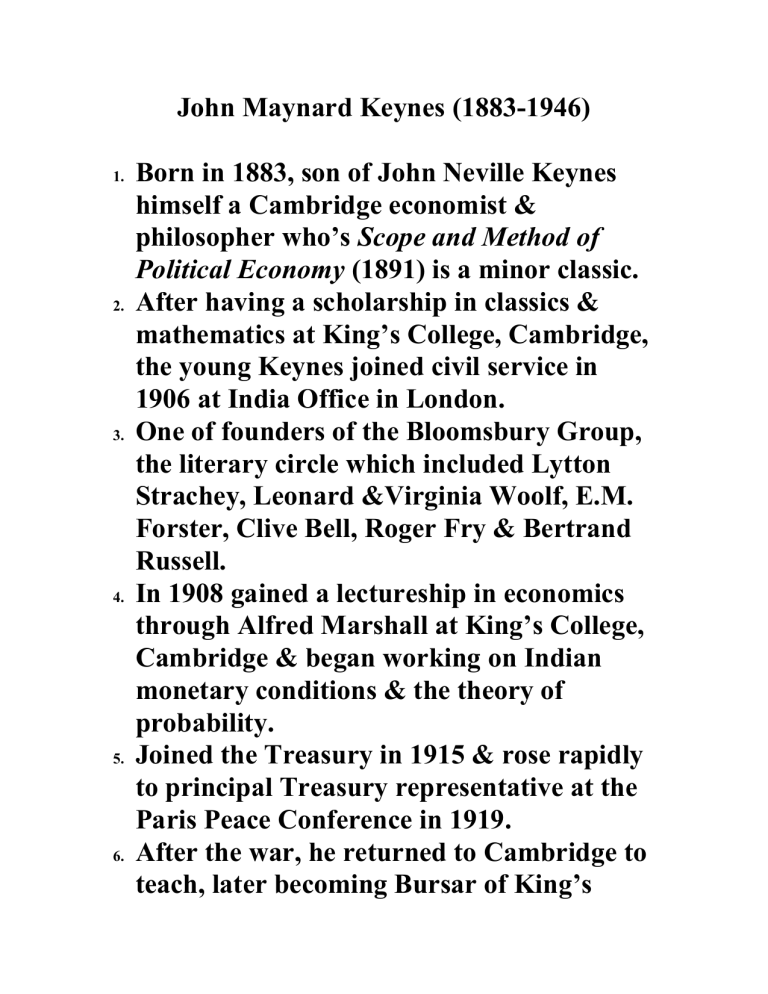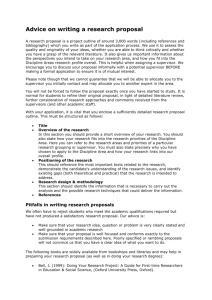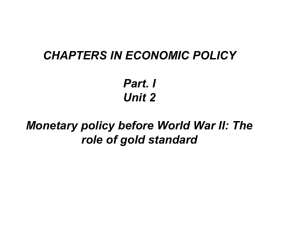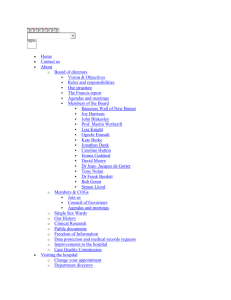John Maynard Keynes (1883-1946)

John Maynard Keynes (1883-1946)
1.
Born in 1883, son of John Neville Keynes himself a Cambridge economist & philosopher who’s Scope and Method of
Political Economy (1891) is a minor classic.
2.
After having a scholarship in classics & mathematics at King’s College, Cambridge, the young Keynes joined civil service in
1906 at India Office in London.
3.
One of founders of the Bloomsbury Group, the literary circle which included Lytton
Strachey, Leonard &Virginia Woolf, E.M.
Forster, Clive Bell, Roger Fry & Bertrand
Russell.
4.
In 1908 gained a lectureship in economics through Alfred Marshall at King’s College,
Cambridge & began working on Indian monetary conditions & the theory of probability.
5.
Joined the Treasury in 1915 & rose rapidly to principal Treasury representative at the
Paris Peace Conference in 1919.
6.
After the war, he returned to Cambridge to teach, later becoming Bursar of King’s
College (managed their investments turning
30,000 pounds into 380,000 pounds).
7.
Began to speculate in foreign exchange ($2 million), an adviser to several business firms, chairmanship of a leading insurance company, wrote frequently for the
Manchester Guardian and The Nation, and edited Economic Journal.
8.
In 1925, he married Lydia Lopokova, a
Russian ballerina.
9.
In 1930 he became a member of the
Economic Advisory Council and of the
Macmillan Committee on Finance and
Industry.
10.
Published a series of memoirs & biographies, notably Essays in Persuasion
(1931) and Essays in Biography (1933).
11.
During WWII he returned to the Treasury
(Churchill wanted him close so that he could watch him) & the last years of his life concentrated on a workable international monetary order. He became Lord Keynes in 1942. His published & unpublished writings are in 30 volumes at The Royal
Economic Society.
12.
Unquestionably the major figure in twentieth-century economics. Reputation does not rest solely on The General Theory
of Employment, Interest and Money (1936), which initiated Keynesian Revolution, but also on other writings, A Treatise on
Probability (1921) and A Treatise on Money
(1930), as well as on his influential advice to the British Treasury, his central role in the
Bretton Woods conference of 1944 that created the International Monetary Fund and the International Bank for
Reconstruction and Development, and his prominent place in the cultural & intellectual life of his day as a journalist and speaker.
13.
His criticism of the Peace Treaty of
Versailles (1919) with Germany in The
Economic Consequences of the Peace (1919) made him famous overnight & effectively undermined public support for the Treaty.
He viewed amount and manner by which
Germany was to pay war reparations to allies would lead to future problems.
Initially, provisions in treaty would hamper
Germany’s post war economy; and ultimately, lead Germany’s repudiation of it and a rearming of all Europe.
14.
His early economic work, Indian Currency
and Finance (1913) and A Tract on
Monetary Reform (1923), was in the
Marshallian tradition, but during the crises of the 1920’s he came increasingly to identify conservative economic policies as the cause of Britain’s economic problems.
15.
He developed a new theory of income determination, grounded in the concept of the ‘consumption function’, the ‘liquidity preference theory of interest’, and the
‘inflexibility of money wages’.
16.
The consumption function referred to a relationship between total consumer spending & national income, such that consumer spending always rises less than proportionately with income, leaving a savings gap that only private or public investment can fill.
17.
The liquidity preference theory of interest emphasized the role of interest rates as the reward for doing without and stressed the
advantages of money as the only perfectly liquid asset.
18.
The inflexibility of money wages, the most controversial of Keynes’ leading principles, was grounded on a realistic appreciation of labor markets in a modern industrial economy.
19.
Full employment, Keynes concluded, could be maintained in a capitalist economy if the government were willing to incur countercyclical budgetary deficits to offset the inbuilt tendency towards private oversaving.
20.
The General Theory is a severely theoretical book with no more than 25 pages devoted to policy implications. It is a book about disagreements in the theory of how the economy works and not about disagreements of what ought to be done about the economy. In fact, many orthodox economists’ years before Keynes had advocated public works, monetary expansion and counter-cyclical budgetary deficits to deal with unemployment.
21.
What was new about Keynes was, first of all, the tendency to work almost exclusively with aggregate, macroeconomic variables and to reduce the entire economy to three markets for goods, bonds and labor;
22.
Secondly, to concentrate on the short period and to confine the analysis of the long period, which had been the principal analytical focus of his predecessors, to asides;
23.
And thirdly, to throw the entire weight of adjustments to changing economic conditions on output or income rather than prices.
24.
Equilibrium for the economy as a whole now involved ‘unemployment equilibrium’, and the introduction of this apparent contradiction in terms involved a profound change in the vision of contemporary economists who had always believed that competitive forces do ultimately drive the economy automatically toward a steady state of full employment.
25.
Classical economists insisted a full employment equilibrium in the long run based on two major propositions:
26. a) households consume part of their income
& save the remainder. If consumers decide to save more, demand for goods & services slips, but this is offset because merchants simply invest more. Why would merchants invest more? When people save, they do not usually stuff bills into their mattresses.
They put money in the bank. The banks lend the money to merchants. Now, if people bring more savings to the bank, the bank will lower the price it charges borrowers, which is the interest rate. And if the bank lowers the interest rate, merchants will borrow more for investment because more projects will appear profitable compared to the cost of borrowing. Thus, whenever consumers boost their saving & reduce their consumption, merchants will be induced to boost their investment. A flexible interest rate will, in Marshallian splendor, tie investment & savings together. We might
say that consumers provide the supply of savings (which rises as interest rates rise, because saving becomes more attractive), while merchants provide a demand for those savings (which falls as interest rates rise). If savings increase, interest rates will fall, investment will increase, which puts money in people’s pockets and sustains the flow.
27. b) flexible wages and prices buttress Say’s law. Suppose all merchants limp. They cannot walk to the bank as fast as consumers do when the consumers raise their savings. Thus, merchants cannot invest quickly enough to make up for the decreased consumption. A slight recession may result. But wages & prices would fall in response to a fall in demand for goods and services. As wages fell, unemployed workers would be rehired. As prices fell, surplus goods would be sold. The recession would be over quickly.
28.
Keynes launched a two-pronged attack on the classical school.
29. a) denied the automatic link between savings and investment. Households & businesses save & invest for completely different reasons. A family saves for future purchases, retirement, etc. Businesses may change their investment plans based on politics, confidence, technology, foreign exchange rates, or who won the World
Series. To expect interest rates to bring harmony is silly. If household savings exceed business investment, gluts will emerge, and bosses will fire employees, leading to even less consumption. As income fall, savings may drop enough to equal investment, but not necessarily at full employment.
30. b) Keynes scoffed at fluid, flexible wages and prices. When politicians prophesy that prices will float to their correct levels, they sound like magicians chanting prophecies that “abra will rise, cadabra will fall.”
Monopolies and union contracts surely impede adjustment. During a recession, real wages should fall, according to classical theory. But workers usually refuse to
accept lower nominal wages, Keynes thought.
31.
In a recession, Keynes argued businesses slash investment. Yes, savings eventually equal investment. But why? Not because investment rises (as the classicists say), but because laid-off employees cannot afford to save. Further, because wages and prices take a long time to adjust; prolonged recessions or depressions are possible. Sure enough, savings did equal investment in the early 1930’s. There was none of either.
The classical show was over.
32.
When an economy goes into an economic tailspin its income contracts and savings will eventually be squeezed out. How could a community be expected to save as much when everyone was hard up as when everyone was prosperous? Asked Keynes.
Quite obviously, it could not. The result of a depression would not be a glut of savings but a drying-up of savings; not a flood of saving, but a trickle.
33.
Monetary policy is ineffective because velocity of money becomes volatile during
recession and create liquidity trap
(pumping money supply will not increase prices). MV=PQ.
34.
In 1929 the American private citizenry put aside $3.7 billion out of its income; by 1932 and 1933 it was saving nothing - in fact, it was even drawing down its old savings made in the years before. Corporations which had tucked away $2.6 billion at the top of the boom after paying out taxes & dividends, found themselves losing nearly
$6 billion three years later.
35.
The larger consequence was that the economy found itself in a condition of paralysis just when it most needed to be dynamic. For if there were no surplus of saving, there would be no pressure on interest rates to encourage businessmen to borrow. And if there were no borrowing & investment spending, there would be no impetus for expansion. The economy would not budge an inch: it would remain in a condition of “equilibrium” despite the presence of unemployed men and women and underutilized plant and equipment.
36.
Thus the paradox of poverty amidst plenty and the anomaly of idle men and idle machines. At bottom of a slump there was a heartless contradiction between a crying need for goods and an insufficiency of production. For the economy did not operate to satisfy human wants - wants are always as large as dreams. It turned out goods to satisfy demand - and demand is related to a person’s pocketbook. Hence the unemployed are economic zeros; they might as well have been on the moon for all the economic influence they exerted on the marketplace.
37.
Warns of inadequate demand for goods and services by households and businesses. If they do not purchase enough, merchants will fire workers and slash output. This is
Keynes’ capsule description of a depression.
38.
Points out the volatility of investment during cycles. The willingness to invest cannot go on indefinitely. Sooner or later, investment contracts. Industry is limited by the size of the market to which it caters.
Investment has its typical pattern: at first,
eagerness to take advantage of a new opportunity or invention; then, caution lest enthusiasm lead to overbuilding; then, inactivity when the market has been satisfied for the time being. If, as each separate investment project came to a halt, another immediately appeared, there need never be a slump. But such is not likely to be the case. Some new invention, some better way of doing things, some intriguing product to catch the public eye and such opportunities are not always there.
39.
The simple Keynesian model: households are the most important component of overall demand. Income is the most important determinant of C. Family size, tastes and expectations can cause the consumption function to change. If income rises, he will spend most of the income & save the rest. That part spent is the marginal propensity to consume.
40.
Businesses also buy goods and services.
Investment much more volatile.
Expectations, interest rates, confidence, weather, and politics could all distort
investment plans. In the simple model, so many factors count that businessmen do not change their investment plans in response to short-run changes in incomes.
41.
To have a healthy economy with full employment, households must consume enough and businesses must invest enough that sales of goods equal the amount produced. If people consumed all of their income (MPC=1), Say’s law would produce full employment. But since people save, business investment must make up for the savings. If is does not, output exceeds sales, inventories build, and employers lay off employees. The problem is deficient demand for goods and services. The culprit in a recession is savings. Keynes calmly claims that well-intentioned savers, including harmless old ladies, inflict more harm than any wicked industrialist.
42.
The harm compounds itself. This is the
Keynesian multiplier (actually borrowed from Richard Kahn). Any change in spending by one person starts a snowball effect, and the ultimate change in national
spending far surpasses the initial change.
M=1/(1-MPC) or 1/MPS.
43.
If we know the MPC, we know the multiplier. Therefore, we (the government) can inject spending into the economy, which will multiply throughout and cure the recession by filling the original gap between output and sales.
44.
Estimated the United States’ multiplier at about 2.5 and advocated massive public spending programs in letters to President
Roosevelt & magazines.
45.
He knew that economists & politicians would attack his activist fiscal policy. They wanted balanced budgets because deficits would emerge. So what, responded Keynes.
During recessions, balanced budgets are stupid, for there are two sides to a budget: tax revenues & outlays. Since in recessions incomes fall, governments collect less in taxes. If the government is obsessed by a balanced budget, it must either cut spending or increase taxes. But each of these squeezes the economy further by the multiplier process! Over the course of
business cycle, budgets should be balanced,
Keynes urged. During prosperity people pay more money in taxes and budget surpluses should result. But during recessions the government should allow deficits. The dunces at the treasuries took a long time to understand this.
46.
In 1964, United States had an estimated $30 billion gap and assumed 2.3 multiplier,
Congress cut personal & business taxes by about $13 billion. No discretionary economic policy ever worked better. In 18 months, the government recovered revenues to offset the tax cut.
47.
In summary, Keynes was interested in level of national income & volume of employment rather than equilibrium of firm or allocation of resources. It was still a problem of demand & supply, but
“demand” means total level of effective demand in economy, and “supply” means nation’s capacity to produce. When effective demand falls short of productive capacity, result is unemployment &
depression; when it exceeds capacity to produce, result is inflation.
48.
Heart of model is an analysis of determinants of effective demand. If ignore foreign trade, effective demand consists of three spending streams: consumption expenditure, investment expenditures, and government expenditures, each of which is independently determined. Attempted to show level of effective demand may well exceed or fall short of physical capacity to produce output: there is no automatic tendency to produce at a level that results in the full employment of all available men and machines.
49.
On the role of inflation: believed a small amount of inflation was good for economy.
Encouraged investment & penalized people that sat & charged interest. Advocated a managed currency relative to a floating price of gold,
50.
On the distribution of income: critical of inequalities in income & wealth but argued some inequality necessary to provide
incentive to entrepreneurs to undertake investment.
51.
On the ownership of resources & property: specifically rejected the need for public or government ownership of means of production. Concerned with aggregate outcomes in the economy. He did not direct attention to issues of what should be produced and how.
52.
Role of government: rejected the
Smith/Classical economics belief of promise of material progress in a laissez-faire environment. Convinced that marketbased economies do not produce full employment automatically. Argued there would be unemployment & depression from time to time in absence of corrective government policies. Government action was essential to stabilize an unstable economy. Need to ‘fine-tune’ economy by running demand-management policies; these were to counter current trends in trade cycle - to speed up activity when there is too little, to slow it down when there is an excess.
53.
The gradual but increasingly widespread acceptance of most of Keynes’ views in the immediate years after WWII raised
Keynesianism, for a while, to position of a prevailing orthodoxy. Price theory & microeconomics took second place to macroeconomics, long period analysis virtually disappeared, and demand management - the view that government can achieve full employment & price stability by fine-tuning the economy - commanded universal assent.
54.
In 1970’s & 1980’s, Milton Friedman,
Robert Lucas & stagflation caused his star to wane for a time. Star status has been revived somewhat recently. Keynes clearly remains one of the three or four most influential economists that ever lived.






